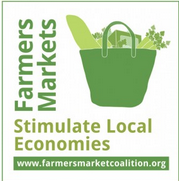Farmers Markets Stimulate Local Economies
 Farmers Markets Stimulate Local Economies
Farmers Markets Stimulate Local Economies
On the next visit to your local farmers market, take a moment to observe the wheels of your local economy in motion. The rows of fresh, colorful produce. The delicious aroma of sizzling fare. The neighborly conversations. At the center of these lovely diversions are the transactions taking place between farmer and customer; the exchange of money for goods.
Enticed by the festive sights, sounds, smells, and tastes, more and more people are choosing to shop for fresh, local foods sold at farmers markets. According to an impact study conducted by Civic Economics, locally owned retailers like farmers markets return more than three times as much of their revenue to the local economy than do their corporate competitors. This means your farmers market purchases not only stock your pantry with healthy, fresh food , but also recycle money throughout your community, boosting economic activity and job creation.
And as the demand for fresh, local food continues to grow, farmers markets are being recognized as important retail anchors for economic commerce. The more than 8,000 markets across the nation are the driving impetus of consumer support for local farmers – while at the same time are creating opportunities for small businesses to stimulate local and regional economies. Farmers markets are more than just a venue for fresh food and a friendly atmosphere; the revenue they generate helps your community prosper.
What are the economic impacts of farmers markets?
National Impacts
- Growers selling locally create 13 full time jobs per $1 million in revenue earned. Those that do not sell locally create 3. [i]
- The USDA estimates that local food sales from farmers markets, food hubs, CSAs, farm stands and farm to schools programs have grown from from about $5 billion in 2008 to $11.7 billion in 2014.
- A 2010 study by USDA’s Economic Research Service compared producers selling salad mix, blueberries, milk, beef, and apples locally with producers of the same products selling to mainstream supply “In all five cases, nearly all of the wage and proprietor income earned in the local market chains is retained in the local economy.” [ii]
- Farms selling local food through direct-to-consumer marketing channels were more likely to remain in business over 2007-12 than all farms not using direct-to-consumer marketing channels, according to US Census of Agriculture data.
State Impacts
- Florida households spent an estimated $1.8 billion at farmers’ markets, roadside stands, and U-pick farms in 2011. [iii]
- In Iowa and Oklahoma, every dollar spent at farmers markets led to an additional $0.58 – $1.36 in sales at other nearby businesses. [iv], [v]
- Farmers markets create between 257 and 361 full-time jobs and generate up to $13 million in South Carolina alone, according to one recent estimate. [vi]
- Wyoming’s economy was bolstered by more than $2.8 million in 2013 from sales at the state’s farmers. [vii]
- Virginia Cooperative Extension reported that Southern Virginia households spending 15% of their weekly food budget on locally grown food products would generate $90 million in new farm income for the region. [viii]
- According to the US Census of Agriculture, 144,530 farms sold $1.3 billion in fresh edible agricultural products directly to consumers in 2012.
Individual Market Impacts
- 41% of shoppers at Portland (Oregon) Farmers Markets said that their main reason for shopping at these markets was to support the local economy.[ix]
- Farmers markets spur spending at neighboring businesses. A 2010 study of the Easton Farmers Market in Pennsylvania found that 70% of farmers market customers are also shopping at downtown businesses, spending up to an extra $26,000 each week.
- At the Crescent City Farmers Market in New Orleans, 32% of Market shoppers spend money at nearby businesses, resulting in $3.2 million in projected gross receipts and an annual contribution of $151,621 to local sales tax revenue.
- Boise, Idaho’s Capital City Public Market generated an estimated $4.5 million in economic activity for the local economy in 2011.
So the next time you shop at your neighborhood farmers market, remember: not only are you appeasing your taste buds, but you’re giving your community a little economic boost. One dollar at a time.
